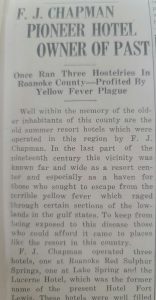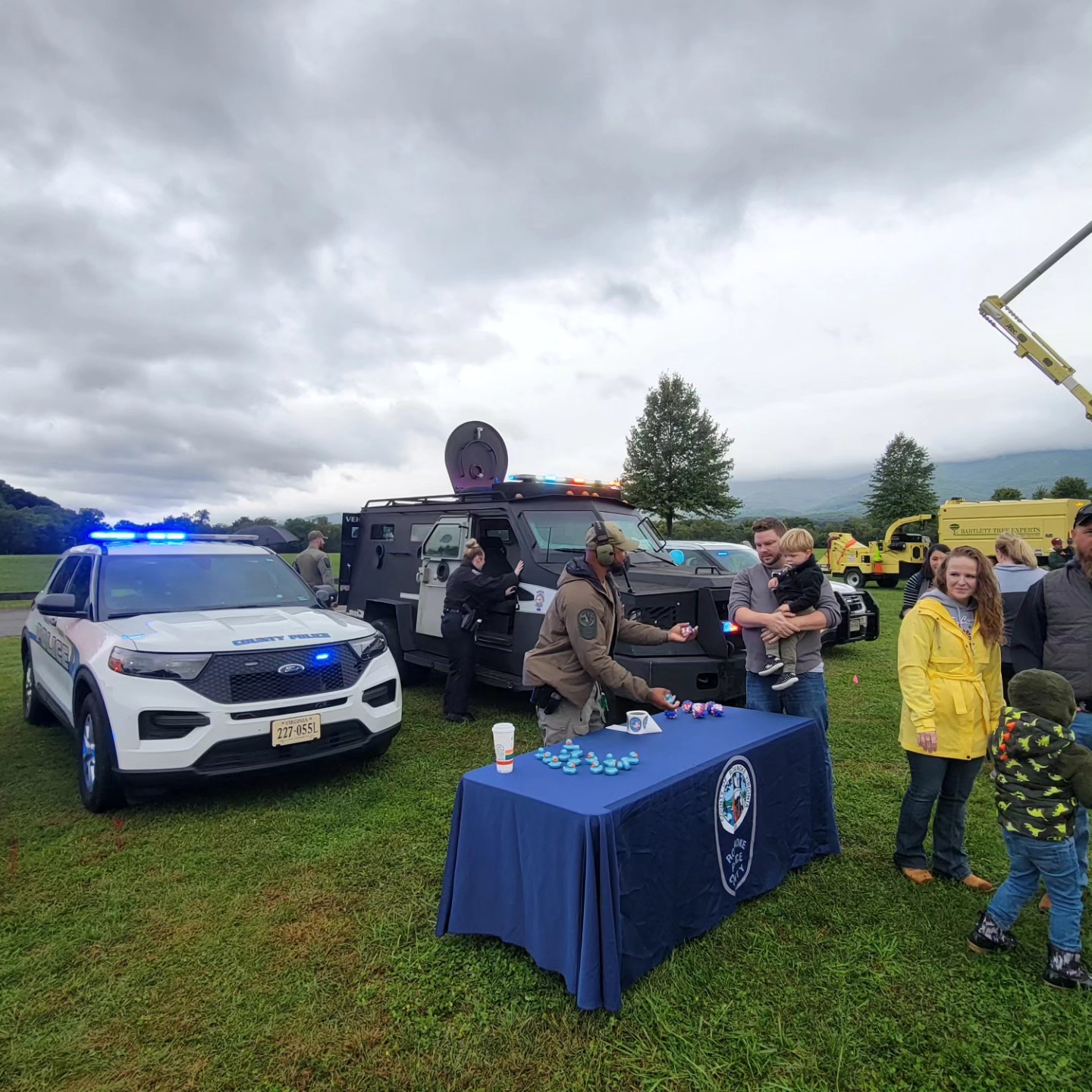
Once Ran Three Hostelries In Roanoke County-Profited By Yellow Fever Plague
From the 1938 centennial edition of The Times-Register
Well within the memory of the older inhabitants of this county are the old summer resort hotels which were operated in this region by F. J. Chapman. In the last part of the nineteenth century this vicinity was known far and wide as a resort center and especially as a haven for those who sought to escape from the terrible yellow fever which raged through certain sections of the lowlands in the gulf states. To keep from being exposed to this disease those who could afford it came to places like the resorts in this country.
- J. Chapman operated three hotels, one at Roanoke Red Sulphur Springs, one at Lake Spring and the Lucerne Hotel, which was the former name of the present Hotel Fort Lewis. These hotels were well filled each summer with people from various sections of the country with many coming from Louisianna, Texas and Arkansas.
Three Hotels
Of the three hotels operated by Mr. Chapman, the Roanoke Red Sulphur Springs hostelry was especially advertised as a health resort with the medical value of the spring waters, the high dry atmosphere and healthful surroundings stressed in telling of the curative properties of the vicinity. Here was situated the famous Red Sulphur Springs which is well known to Roanoke residents at the place where the Catawba Sanitorium is now located.
From this place was shipped a large amount of mineral water in the past century. The cost of this water was advertised as being $4.00 per case of twelve half-gallon bottles. Two different kinds of water were sold, one being called “Roanoke Red Sulphur” and the other “Catawba Iron, or All Healing.”
Board at this resort hotel in 1889 was very reasonable as the rates, as advertised in one of the old booklets, was $40 per month or $12.50 per week, and $2.50 per day with special rates for families and half rates given to children and servants.
In the old advertising booklet published in 1889 and owned by Mrs. Jessie Hammit are found testimonials from people in various sections of the south and also persons from New York, Philadelphia and Baltimore. From San Antonio, Texas came a testimonial from a Dr. E. Cross in which that doctor promised to send some patients to Red Sulphur Springs as he considered it a most beneficial place for those affected with lung disease. Today San Antonio is widely known as a most healthful locality for people tuberculosis and thousands of lung sufferers have gone to that part of Texas in the past ten or fifteen years.
300 Guests
Three hundred guests could be accommodated at the old hotel at Red Sulphur Springs as Mr. Chapman had a number of cottages to rent as well as hotel accommodation.
Life at Red Sulphur Springs in 1887 is described as follows by a guest who signed the name of W. H. Beveridge:
“Arriving at the Springs you will be met by mine host, F. J. Chapman (commonly known as Joe Chapman) or Harry Chapman, who will immediately proceed to make you feel at home; then such a dinner is not always found at springs, for what Chapman has is good and well-cooked. AT the Red in the summer of 1887 there were about three hundred, most of whom were southerners and a more sociable or home-like people that cannot be found in America, from the oldest man (all ladies are young and lovely) to the youngest child seem bent and determined that everybody shall have a good time at the Red and be made to feel at home. The young people have the delightful German and hops every night. We older people amuse ourselves in various ways – fishing, gunning checker parties, etc., with the ladies, God bless them, enlivening every amusement except hunting. The rambles for the young , old, sick or well cannot be equaled. The waters are Red Sulphur, peculiarly adapted to the cure of pulmonary troubles. Among the places to visit is McAfee’s Knob from whose elevation at 4,428 feet you will observe one of the loveliest valleys in Virginia, scarcely equaled by the Alps.”
Accommodations at the Lake Spring hotel including the cottages were capable of caring for about one hundred and fifty people, and this place also was well filled in summer. A Spacious dancing floor at this place afforded nightly amusement in this line. Both hotels being under the same management, the guests were given the privilege of dividing their time between the mountain resort and the Lake Spring hotel but the price of board was higher at Red Sulphur Springs.
Lake Spring
At Lake Spring were three natural basins of pure cold water that covered an aggregate area of three acres. In the center of the lake was a small bandstand in which a little Italian string band furnished music for those who enjoyed boating. This place with its cool shade of the willows provided a fine place for rowboats.
The little bandstand that now stands on the bank of the lake was moved from the courthouse lawn where it was used to muster in soldiers during the War Between the States, it is said.
Toward the close of each season what was known as “The Tournament” was held annually and this affair was the big social event of the season. Horseback riders-each of whom was known as a knight- were armed with lances which they endeavored to run through rings. These rings were detachable and strung out in a row for about eighty feet. To the knight who ran his lance through the most rings went the honor of crowning the queen of the ball. The big ball was held at the dance pavilion of the Lake Spring hotel and was the most elaborate one of the seasons.
Science and competing resort facilities combined to detract from this county as a summer resort. Yellow fever was overcome and other summer resorts sprang up in various sections of the country in the mountain area, while beach resorts soon began to be popular.
In the old days there were about five hundred tourists who spent the summer here as the Lucerne hotel was also largely a tourist hotel at that time.
-Prepared by Lisa King





